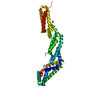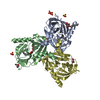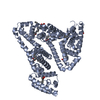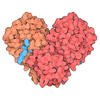+ Open data
Open data
- Basic information
Basic information
| Entry | Database: PDB / ID: 4wqo | ||||||
|---|---|---|---|---|---|---|---|
| Title | Structure of VHL-EloB-EloC-Cul2 | ||||||
 Components Components |
| ||||||
 Keywords Keywords |  TRANSCRIPTION / TRANSCRIPTION /  E3 ligase complex E3 ligase complex | ||||||
| Function / homology |  Function and homology information Function and homology informationregulation of cellular response to hypoxia / RHOBTB3 ATPase cycle / negative regulation of receptor signaling pathway via JAK-STAT / transcription elongation factor activity / ubiquitin-dependent protein catabolic process via the C-end degron rule pathway / target-directed miRNA degradation / elongin complex / VCB complex / Replication of the SARS-CoV-1 genome / Cul5-RING ubiquitin ligase complex ...regulation of cellular response to hypoxia / RHOBTB3 ATPase cycle / negative regulation of receptor signaling pathway via JAK-STAT / transcription elongation factor activity / ubiquitin-dependent protein catabolic process via the C-end degron rule pathway / target-directed miRNA degradation / elongin complex / VCB complex / Replication of the SARS-CoV-1 genome / Cul5-RING ubiquitin ligase complex /  SCF ubiquitin ligase complex / Cul2-RING ubiquitin ligase complex / ubiquitin ligase complex scaffold activity / SCF-dependent proteasomal ubiquitin-dependent protein catabolic process / intracellular non-membrane-bounded organelle / SUMOylation of ubiquitinylation proteins / negative regulation of transcription elongation by RNA polymerase II / Pausing and recovery of Tat-mediated HIV elongation / Tat-mediated HIV elongation arrest and recovery / HIV elongation arrest and recovery / Pausing and recovery of HIV elongation / ubiquitin-like ligase-substrate adaptor activity / Tat-mediated elongation of the HIV-1 transcript / Formation of HIV-1 elongation complex containing HIV-1 Tat / Formation of HIV elongation complex in the absence of HIV Tat / negative regulation of signal transduction / RNA Polymerase II Transcription Elongation / Formation of RNA Pol II elongation complex / negative regulation of TORC1 signaling / RNA Polymerase II Pre-transcription Events / intrinsic apoptotic signaling pathway / negative regulation of autophagy / transcription corepressor binding / Evasion by RSV of host interferon responses / transcription elongation by RNA polymerase II / SCF ubiquitin ligase complex / Cul2-RING ubiquitin ligase complex / ubiquitin ligase complex scaffold activity / SCF-dependent proteasomal ubiquitin-dependent protein catabolic process / intracellular non-membrane-bounded organelle / SUMOylation of ubiquitinylation proteins / negative regulation of transcription elongation by RNA polymerase II / Pausing and recovery of Tat-mediated HIV elongation / Tat-mediated HIV elongation arrest and recovery / HIV elongation arrest and recovery / Pausing and recovery of HIV elongation / ubiquitin-like ligase-substrate adaptor activity / Tat-mediated elongation of the HIV-1 transcript / Formation of HIV-1 elongation complex containing HIV-1 Tat / Formation of HIV elongation complex in the absence of HIV Tat / negative regulation of signal transduction / RNA Polymerase II Transcription Elongation / Formation of RNA Pol II elongation complex / negative regulation of TORC1 signaling / RNA Polymerase II Pre-transcription Events / intrinsic apoptotic signaling pathway / negative regulation of autophagy / transcription corepressor binding / Evasion by RSV of host interferon responses / transcription elongation by RNA polymerase II /  transcription initiation at RNA polymerase II promoter / positive regulation of cell differentiation / TP53 Regulates Transcription of DNA Repair Genes / Vif-mediated degradation of APOBEC3G / Oxygen-dependent proline hydroxylation of Hypoxia-inducible Factor Alpha / cell morphogenesis / Inactivation of CSF3 (G-CSF) signaling / G1/S transition of mitotic cell cycle / Regulation of expression of SLITs and ROBOs / ubiquitin-protein transferase activity / transcription corepressor activity / positive regulation of proteasomal ubiquitin-dependent protein catabolic process / Antigen processing: Ubiquitination & Proteasome degradation / protein-macromolecule adaptor activity / transcription initiation at RNA polymerase II promoter / positive regulation of cell differentiation / TP53 Regulates Transcription of DNA Repair Genes / Vif-mediated degradation of APOBEC3G / Oxygen-dependent proline hydroxylation of Hypoxia-inducible Factor Alpha / cell morphogenesis / Inactivation of CSF3 (G-CSF) signaling / G1/S transition of mitotic cell cycle / Regulation of expression of SLITs and ROBOs / ubiquitin-protein transferase activity / transcription corepressor activity / positive regulation of proteasomal ubiquitin-dependent protein catabolic process / Antigen processing: Ubiquitination & Proteasome degradation / protein-macromolecule adaptor activity /  Neddylation / Replication of the SARS-CoV-2 genome / cellular response to hypoxia / ubiquitin-dependent protein catabolic process / Neddylation / Replication of the SARS-CoV-2 genome / cellular response to hypoxia / ubiquitin-dependent protein catabolic process /  regulation of gene expression / proteasome-mediated ubiquitin-dependent protein catabolic process / protein-containing complex assembly / DNA-binding transcription factor binding / amyloid fibril formation / molecular adaptor activity / protein stabilization / protein ubiquitination / negative regulation of cell population proliferation / negative regulation of gene expression / regulation of gene expression / proteasome-mediated ubiquitin-dependent protein catabolic process / protein-containing complex assembly / DNA-binding transcription factor binding / amyloid fibril formation / molecular adaptor activity / protein stabilization / protein ubiquitination / negative regulation of cell population proliferation / negative regulation of gene expression /  ubiquitin protein ligase binding / protein-containing complex binding / regulation of DNA-templated transcription / ubiquitin protein ligase binding / protein-containing complex binding / regulation of DNA-templated transcription /  nucleolus / regulation of transcription by RNA polymerase II / negative regulation of apoptotic process / positive regulation of DNA-templated transcription / nucleolus / regulation of transcription by RNA polymerase II / negative regulation of apoptotic process / positive regulation of DNA-templated transcription /  enzyme binding / negative regulation of transcription by RNA polymerase II / enzyme binding / negative regulation of transcription by RNA polymerase II /  endoplasmic reticulum / endoplasmic reticulum /  mitochondrion / mitochondrion /  proteolysis / proteolysis /  nucleoplasm / nucleoplasm /  nucleus / nucleus /  plasma membrane / plasma membrane /  cytosol cytosolSimilarity search - Function | ||||||
| Biological species |   Homo sapiens (human) Homo sapiens (human) | ||||||
| Method |  X-RAY DIFFRACTION / X-RAY DIFFRACTION /  SYNCHROTRON / SYNCHROTRON /  MOLECULAR REPLACEMENT / MOLECULAR REPLACEMENT /  molecular replacement / Resolution: 3.2 Å molecular replacement / Resolution: 3.2 Å | ||||||
 Authors Authors | Nguyen, H.C. / Xiong, Y. | ||||||
 Citation Citation |  Journal: Structure / Year: 2015 Journal: Structure / Year: 2015Title: Insights into Cullin-RING E3 Ubiquitin Ligase Recruitment: Structure of the VHL-EloBC-Cul2 Complex. Authors: Nguyen, H.C. / Yang, H. / Fribourgh, J.L. / Wolfe, L.S. / Xiong, Y. | ||||||
| History |
|
- Structure visualization
Structure visualization
| Structure viewer | Molecule:  Molmil Molmil Jmol/JSmol Jmol/JSmol |
|---|
- Downloads & links
Downloads & links
- Download
Download
| PDBx/mmCIF format |  4wqo.cif.gz 4wqo.cif.gz | 215.5 KB | Display |  PDBx/mmCIF format PDBx/mmCIF format |
|---|---|---|---|---|
| PDB format |  pdb4wqo.ent.gz pdb4wqo.ent.gz | 172.9 KB | Display |  PDB format PDB format |
| PDBx/mmJSON format |  4wqo.json.gz 4wqo.json.gz | Tree view |  PDBx/mmJSON format PDBx/mmJSON format | |
| Others |  Other downloads Other downloads |
-Validation report
| Arichive directory |  https://data.pdbj.org/pub/pdb/validation_reports/wq/4wqo https://data.pdbj.org/pub/pdb/validation_reports/wq/4wqo ftp://data.pdbj.org/pub/pdb/validation_reports/wq/4wqo ftp://data.pdbj.org/pub/pdb/validation_reports/wq/4wqo | HTTPS FTP |
|---|
-Related structure data
- Links
Links
- Assembly
Assembly
| Deposited unit | 
| ||||||||
|---|---|---|---|---|---|---|---|---|---|
| 1 |
| ||||||||
| Unit cell |
|
- Components
Components
| #1: Protein | Mass: 26352.113 Da / Num. of mol.: 1 Source method: isolated from a genetically manipulated source Source: (gene. exp.)   Homo sapiens (human) / Gene: VHL / Production host: Homo sapiens (human) / Gene: VHL / Production host:   Escherichia coli (E. coli) / References: UniProt: P40337 Escherichia coli (E. coli) / References: UniProt: P40337 |
|---|---|
| #2: Protein | Mass: 13147.781 Da / Num. of mol.: 1 Source method: isolated from a genetically manipulated source Source: (gene. exp.)   Homo sapiens (human) / Gene: TCEB2 / Production host: Homo sapiens (human) / Gene: TCEB2 / Production host:   Escherichia coli (E. coli) / References: UniProt: Q15370 Escherichia coli (E. coli) / References: UniProt: Q15370 |
| #3: Protein | Mass: 10843.420 Da / Num. of mol.: 1 / Fragment: UNP residues 17-112 Source method: isolated from a genetically manipulated source Source: (gene. exp.)   Homo sapiens (human) / Gene: TCEB1 / Production host: Homo sapiens (human) / Gene: TCEB1 / Production host:   Escherichia coli (E. coli) / References: UniProt: Q15369 Escherichia coli (E. coli) / References: UniProt: Q15369 |
| #4: Protein |  CUL2 / CUL-2 CUL2 / CUL-2Mass: 22131.480 Da / Num. of mol.: 1 / Fragment: UNP residues 20-122 Source method: isolated from a genetically manipulated source Source: (gene. exp.)   Homo sapiens (human) / Gene: CUL2 / Production host: Homo sapiens (human) / Gene: CUL2 / Production host:   Escherichia coli (E. coli) / References: UniProt: Q13617 Escherichia coli (E. coli) / References: UniProt: Q13617 |
-Experimental details
-Experiment
| Experiment | Method:  X-RAY DIFFRACTION / Number of used crystals: 1 X-RAY DIFFRACTION / Number of used crystals: 1 |
|---|
- Sample preparation
Sample preparation
| Crystal | Density Matthews: 4.99 Å3/Da / Density % sol: 75.35 % |
|---|---|
Crystal grow | Temperature: 298 K / Method: microbatch / Details: 4M Na formate |
-Data collection
| Diffraction | Mean temperature: 100 K |
|---|---|
| Diffraction source | Source:  SYNCHROTRON / Site: SYNCHROTRON / Site:  NSLS NSLS  / Beamline: X29A / Wavelength: 1.075 Å / Beamline: X29A / Wavelength: 1.075 Å |
| Detector | Type: ADSC QUANTUM 315 / Detector: CCD / Date: Sep 28, 2012 |
| Radiation | Protocol: SINGLE WAVELENGTH / Monochromatic (M) / Laue (L): M / Scattering type: x-ray |
| Radiation wavelength | Wavelength : 1.075 Å / Relative weight: 1 : 1.075 Å / Relative weight: 1 |
| Reflection | Resolution: 3.2→48.3 Å / Num. obs: 24321 / % possible obs: 99.8 % / Redundancy: 5.8 % / Rmerge(I) obs: 0.084 / Net I/σ(I): 16.4 |
| Reflection shell | Resolution: 3.2→3.3 Å / Redundancy: 5.9 % / Mean I/σ(I) obs: 1.1 / % possible all: 99.9 |
-Phasing
Phasing | Method:  molecular replacement molecular replacement |
|---|
- Processing
Processing
| Software |
| |||||||||||||||||||||||||||||||||||||||||||||||||||||||||||||||||||||||||||||||||||||||||||||||||||||||||||||||||||||||||||||
|---|---|---|---|---|---|---|---|---|---|---|---|---|---|---|---|---|---|---|---|---|---|---|---|---|---|---|---|---|---|---|---|---|---|---|---|---|---|---|---|---|---|---|---|---|---|---|---|---|---|---|---|---|---|---|---|---|---|---|---|---|---|---|---|---|---|---|---|---|---|---|---|---|---|---|---|---|---|---|---|---|---|---|---|---|---|---|---|---|---|---|---|---|---|---|---|---|---|---|---|---|---|---|---|---|---|---|---|---|---|---|---|---|---|---|---|---|---|---|---|---|---|---|---|---|---|---|
| Refinement | Method to determine structure : :  MOLECULAR REPLACEMENT MOLECULAR REPLACEMENTStarting model: 1LM8 and 2WZK Resolution: 3.2→48.297 Å / SU ML: 0.45 / Cross valid method: FREE R-VALUE / σ(F): 1.33 / Phase error: 31.7 / Stereochemistry target values: ML
| |||||||||||||||||||||||||||||||||||||||||||||||||||||||||||||||||||||||||||||||||||||||||||||||||||||||||||||||||||||||||||||
| Solvent computation | Shrinkage radii: 0.9 Å / VDW probe radii: 1.11 Å / Solvent model: FLAT BULK SOLVENT MODEL | |||||||||||||||||||||||||||||||||||||||||||||||||||||||||||||||||||||||||||||||||||||||||||||||||||||||||||||||||||||||||||||
| Displacement parameters | Biso max: 262.44 Å2 / Biso mean: 122.9544 Å2 / Biso min: 77.96 Å2 | |||||||||||||||||||||||||||||||||||||||||||||||||||||||||||||||||||||||||||||||||||||||||||||||||||||||||||||||||||||||||||||
| Refinement step | Cycle: final / Resolution: 3.2→48.297 Å
| |||||||||||||||||||||||||||||||||||||||||||||||||||||||||||||||||||||||||||||||||||||||||||||||||||||||||||||||||||||||||||||
| Refine LS restraints |
| |||||||||||||||||||||||||||||||||||||||||||||||||||||||||||||||||||||||||||||||||||||||||||||||||||||||||||||||||||||||||||||
| LS refinement shell | Refine-ID: X-RAY DIFFRACTION / Total num. of bins used: 8
| |||||||||||||||||||||||||||||||||||||||||||||||||||||||||||||||||||||||||||||||||||||||||||||||||||||||||||||||||||||||||||||
| Refinement TLS params. | Method: refined / Refine-ID: X-RAY DIFFRACTION
| |||||||||||||||||||||||||||||||||||||||||||||||||||||||||||||||||||||||||||||||||||||||||||||||||||||||||||||||||||||||||||||
| Refinement TLS group |
|
 Movie
Movie Controller
Controller















 PDBj
PDBj













